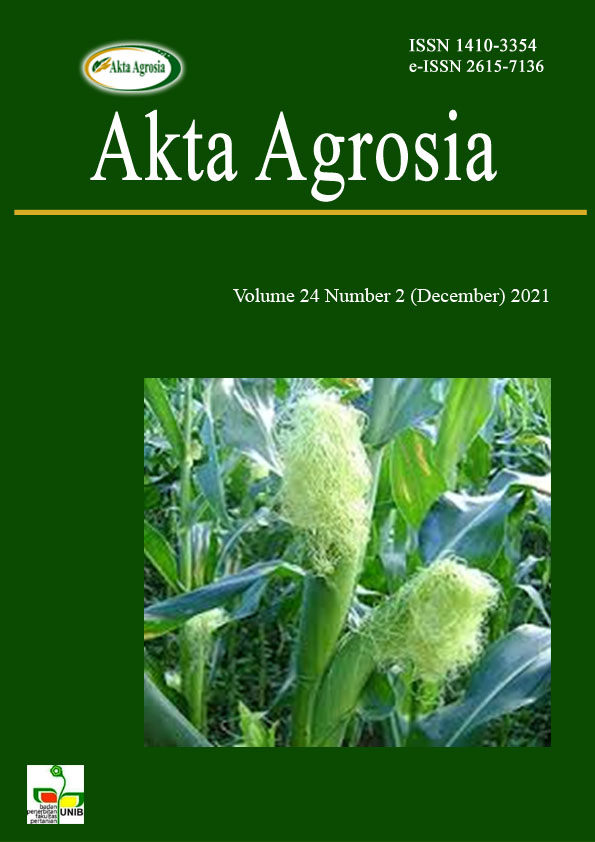Main Article Content
Abstract
Generative propagation of orchid plants has problems because orchid seeds do not have endosperm that need to be multiplied using tissue culture. Contamination is a limiting factor in the multiplication of plants in tissue culture. This study describes the types of contaminants found in Bromheadia finlaysoniana callus. This research was carried out in two stages. The first stage is carried out culture of various explants of Bromheadia finlaysoniana using murashige and Skoog media with enrichment of hormone Benzylaminopurine 1 mg/l; (Naphthalene acetic acid) 0.5 mg/l; 100 mg mynositol; pyridoxine-HCl 0.5 mg/l; thiamine-HCl 0.1 mg/l; nicotinic-acid 0.5 mg/l; glycine 2 mg/l. The second stage is observed and the percentage of contaminant fungi. The observed contaminants character includes the colour, the direction of growth, and the hyphae colony's shape. Determination of contaminants type compared to the morphology of references. The result is the highest contamination in flower stalk explants, 81%; most colonies on leaf explants are 28. Contaminant fungi grow predominantly of fungi with white and grey colour and a rough surface shape. The macroscopic character of contaminant fungi in tissue cultures mostly comes from the class of Deuteromycetes and Zygomycetes.
Keywords: Bromheadia finlaysoniana , contaminant, fungi, tissue culture
Article Details
Copyright (c) 2021 Desta Desta Andriani, Pebra Heriansyah

This work is licensed under a Creative Commons Attribution-ShareAlike 4.0 International License.
Authors who publish with this journal agree to the following terms:
- Authors retain copyright and grant the journal right of first publication with the work simultaneously licensed under a Creative Commons Attribution License that allows others to share the work with an acknowledgement of the work's authorship and initial publication in this journal.
- Authors are able to enter into separate, additional contractual arrangements for the non-exclusive distribution of the journal's published version of the work (e.g., post it to an institutional repository or publish it in a book), with an acknowledgement of its initial publication in this journal.
- Authors are permitted and encouraged to post their work online (e.g. in institutional repositories or on their website) prior to and during the submission process, as it can lead to productive exchanges, as well as earlier and greater citation of published work (See The Effect of Open Access).
References
- Andersen, T. F. & H. N. Rasmussen. (1996). The Mycorrhizal Species of Rhizctonia. In Sneh, B., S. Jabaji Hare, S. Neate, & G. Dijst (Eds). Rhizoctonia Species: Taxonomy, Molecular Biology, Ecology, Pathology and Disease Control. (pp. 379-390). London: KAP.
- Basri, Z. 2004. Kultur Jaringan Tanaman Universitas Tadulako Press. Palu.
- Bey, Y., W. Syafii, dan N. Ngatifah. 2006. Effect of Giberelin Giving on Vacint and Went media on the germination of Moon Orchid Seeds (Phalaenopsis amabilis BL) in In Vitro Jurnal Biogenesis.vol 14,no. 1,:15-21
- Gunawan, L.W. 2004. Budidaya Anggrek. Penebar Swadaya. Jakarta.
- Juarna K.S 2016. Contamination explan Centella asiatica (L.) Urban (Pegagan) In Vitro culture through comparison of two sterilization methods. Jurnal Pro-Life. 3: 2.119-128
- Murashige, T. & Skoog, F. 1962. A revised medium for rapid growth and bioassays with tobacco tissue cultures. Physiol. Plant. 15, 472-497.
- Oratmangun K.M, Pandiangana D * , Febby E. Kandou F.E. 2017. Description Types of Contaminants From Culture Callus Catharanthus roseus (L.) G. Don. Jurnal MIPA Unsrat Online.6 : (1). 47--52
- Puspitaningtyas D. M. 2009. exploration of plants in the Suaka Margasatwa Bukit Rimbang Baling. Paper presented at Proceedings of Seminar keanekaragaman hayati. Maliki, Malang. Malang, Indonesian
- Waluyo, L., 2004, Mikrobiologi Umum, Malang, UMM press
- Wati, T , Astarini I.A, Pharmawati M, Hendriyani E. 2020. Propagation Of Begonia Bimaensis Undaharta & Ardaka Using Tissue Cultura Technique. Journal of Biological Sciences 7(1): 112-122. DOI: 10.24843/metamorfosa.2020.v07.i01.p15
References
Andersen, T. F. & H. N. Rasmussen. (1996). The Mycorrhizal Species of Rhizctonia. In Sneh, B., S. Jabaji Hare, S. Neate, & G. Dijst (Eds). Rhizoctonia Species: Taxonomy, Molecular Biology, Ecology, Pathology and Disease Control. (pp. 379-390). London: KAP.
Basri, Z. 2004. Kultur Jaringan Tanaman Universitas Tadulako Press. Palu.
Bey, Y., W. Syafii, dan N. Ngatifah. 2006. Effect of Giberelin Giving on Vacint and Went media on the germination of Moon Orchid Seeds (Phalaenopsis amabilis BL) in In Vitro Jurnal Biogenesis.vol 14,no. 1,:15-21
Gunawan, L.W. 2004. Budidaya Anggrek. Penebar Swadaya. Jakarta.
Juarna K.S 2016. Contamination explan Centella asiatica (L.) Urban (Pegagan) In Vitro culture through comparison of two sterilization methods. Jurnal Pro-Life. 3: 2.119-128
Murashige, T. & Skoog, F. 1962. A revised medium for rapid growth and bioassays with tobacco tissue cultures. Physiol. Plant. 15, 472-497.
Oratmangun K.M, Pandiangana D * , Febby E. Kandou F.E. 2017. Description Types of Contaminants From Culture Callus Catharanthus roseus (L.) G. Don. Jurnal MIPA Unsrat Online.6 : (1). 47--52
Puspitaningtyas D. M. 2009. exploration of plants in the Suaka Margasatwa Bukit Rimbang Baling. Paper presented at Proceedings of Seminar keanekaragaman hayati. Maliki, Malang. Malang, Indonesian
Waluyo, L., 2004, Mikrobiologi Umum, Malang, UMM press
Wati, T , Astarini I.A, Pharmawati M, Hendriyani E. 2020. Propagation Of Begonia Bimaensis Undaharta & Ardaka Using Tissue Cultura Technique. Journal of Biological Sciences 7(1): 112-122. DOI: 10.24843/metamorfosa.2020.v07.i01.p15
